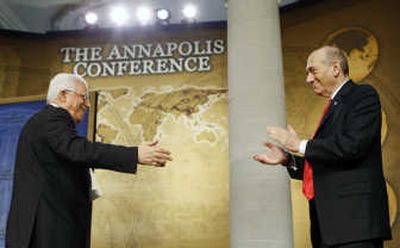Abbas, Olmert sign peace-seeking pact

ANNAPOLIS, Md. – Israeli and Palestinian leaders formally agreed at an international conference Tuesday to launch their first set of peace negotiations in seven years but failed in tortuous private discussions to resolve key questions over the content and structure of the talks.
As a result, a day that began with handshakes and hopes for peace ended with undispelled doubts over the prospect for success of the renewed effort to end decades of strife in the Middle East.
Palestinian and Israeli representatives each said they were satisfied with the outcome of the conference, but there were clear indications that the Israelis came away with a greater share of what they were seeking. Both the Bush administration’s approach to talks and a joint declaration negotiated by the Israelis and Palestinians leaned toward Israeli positions.
Among world dignitaries assembled for the conference, some urged a more active U.S. role while Arab countries demanded greater flexibility by Israel. Saudi representatives called for an even broader peace process for the region to settle long-standing differences between Israel and its neighbors.
President Bush opened the conference at the U.S. Naval Academy by reading aloud a declaration that was completed by Israeli Prime Minister Ehud Olmert and Palestinian President Mahmoud Abbas only minutes before the conference began.
In the statement, called a “joint understanding,” Israelis and Palestinians pledged to begin negotiations in December, with a goal of creating a Palestinian state before the end of Bush’s term.
“We agree to immediately launch good faith bilateral negotiations in order to conclude a peace treaty resolving all outstanding issues, including all core issues, without exception,” said the declaration, which Bush read with Olmert and Abbas standing at his side .
The conference, attended by more than 50 countries and world organizations, was convened to provide the blessing of world powers – including key Arab nations – for renewal of a peace effort that had remained nearly moribund since former President Clinton failed to help complete a settlement at the end of his presidency.
Olmert and Abbas, who spoke to the international gathering after Bush and will meet the president again today at the White House, each vowed to sacrifice in the interests of peace.
Despite statements of mutual support, the vague wording of the joint declaration signaled that the Israelis had emerged from the conference with more of what they wanted than the Palestinians.
The Olmert government, worried about critics on its right, appeared successful in their effort to begin negotiations without yielding on anything ahead of time. Abbas’ team, by contrast, had sought some sort of Israeli concessions up front to show his public that his alliance with the West is producing benefits in the lives of ordinary Palestinians.
The joint declaration sets a date, Dec. 12, for the beginning of talks but sets no deadline for completing a peace deal, as the Palestinians wanted. It specifies only that the two sides will “make every effort” to reach a deal before Bush’s term ends.
The declaration leaves key aspects of the American role undefined, even though the Palestinians and many Arab and European nations have pushed for the United States to act as a broker and press the sides to compromise as has been the case in past presidential administrations.
The declaration also does not address the substance of the core issues dividing the two sides, including borders, refugees, Jerusalem and Israeli settlements. Nor does it say anything about what the Palestinian state that would emerge from a deal would look like.